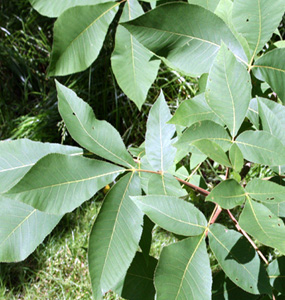Carya sp.

| Click to Enlarge |
|
Family: Juglandaceae Latin Name: Carya sp. Common Name: Hickory General Description: Medium-sized to large trees, with some species often reaching 18 to 25 m (60 to 80 ft) and several capable of exceeding 30 m (100 ft) Geographical Distribution: Throughout the eastern United States, with some species extending as far west as Texas and also into Canada Ecological Distribution: Found in a variety of different situations but most common on moist but well-drained sites Mycorrhizal Status: Endomycorrhizal Additional Notes: Three common species of hickory in NCR Parks are pignut hickory (Carya glabra [Miller] Sweet), shagbark hickory (Carya ovata [Miller] K. Koch) and mockernut hickory (Carya alba [L.] Nutt.). Pignut hickory has leaves divided into five (or sometimes seven) leaflets, a nut with a thin husk and twigs that are smooth. The leaves of shagbark hickory also have five (or sometimes seven) leaflets, but the nut has a very thick husk. Moreover, the major distinguishing feature of shagbark hickory (and the basis for the common name) is the shaggy bark of mature trees. The bark tends to peel off in elongated pieces that curl outward at the ends. As such, this tree is easy to identify even when there are no leaves present. Mockernut hickory has leaves divided into seven (less commonly nine) leaflets, a nut with a thick husk (although less so than that of shagbark hickory) and twigs that are conspicuously hairy. In addition, this species can be identified from the strong, spicy odor that is readily apparent when a leaflet is crushed between the thumb and fingers.
|
| Go Back |